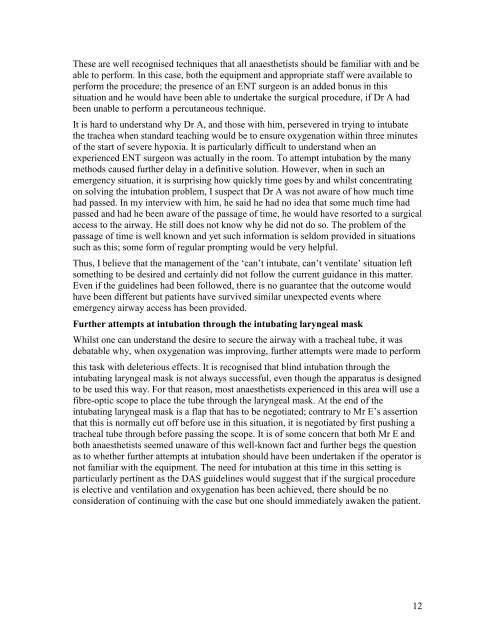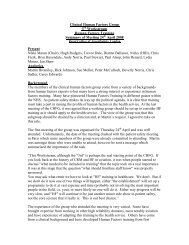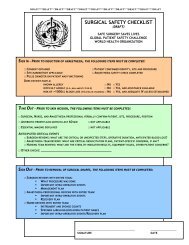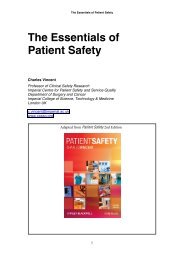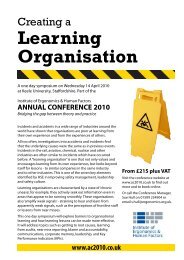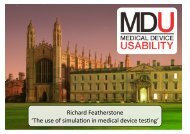Read an anonymous version of Elaine's report, the Inquest Verdict ...
Read an anonymous version of Elaine's report, the Inquest Verdict ...
Read an anonymous version of Elaine's report, the Inquest Verdict ...
You also want an ePaper? Increase the reach of your titles
YUMPU automatically turns print PDFs into web optimized ePapers that Google loves.
These are well recognised techniques that all <strong>an</strong>aes<strong>the</strong>tists should be familiar with <strong>an</strong>d beable to perform. In this case, both <strong>the</strong> equipment <strong>an</strong>d appropriate staff were available toperform <strong>the</strong> procedure; <strong>the</strong> presence <strong>of</strong> <strong>an</strong> ENT surgeon is <strong>an</strong> added bonus in thissituation <strong>an</strong>d he would have been able to undertake <strong>the</strong> surgical procedure, if Dr A hadbeen unable to perform a percut<strong>an</strong>eous technique.It is hard to underst<strong>an</strong>d why Dr A, <strong>an</strong>d those with him, persevered in trying to intubate<strong>the</strong> trachea when st<strong>an</strong>dard teaching would be to ensure oxygenation within three minutes<strong>of</strong> <strong>the</strong> start <strong>of</strong> severe hypoxia. It is particularly difficult to underst<strong>an</strong>d when <strong>an</strong>experienced ENT surgeon was actually in <strong>the</strong> room. To attempt intubation by <strong>the</strong> m<strong>an</strong>ymethods caused fur<strong>the</strong>r delay in a definitive solution. However, when in such <strong>an</strong>emergency situation, it is surprising how quickly time goes by <strong>an</strong>d whilst concentratingon solving <strong>the</strong> intubation problem, I suspect that Dr A was not aware <strong>of</strong> how much timehad passed. In my interview with him, he said he had no idea that some much time hadpassed <strong>an</strong>d had he been aware <strong>of</strong> <strong>the</strong> passage <strong>of</strong> time, he would have resorted to a surgicalaccess to <strong>the</strong> airway. He still does not know why he did not do so. The problem <strong>of</strong> <strong>the</strong>passage <strong>of</strong> time is well known <strong>an</strong>d yet such information is seldom provided in situationssuch as this; some form <strong>of</strong> regular prompting would be very helpful.Thus, I believe that <strong>the</strong> m<strong>an</strong>agement <strong>of</strong> <strong>the</strong> „c<strong>an</strong>‟t intubate, c<strong>an</strong>‟t ventilate‟ situation leftsomething to be desired <strong>an</strong>d certainly did not follow <strong>the</strong> current guid<strong>an</strong>ce in this matter.Even if <strong>the</strong> guidelines had been followed, <strong>the</strong>re is no guar<strong>an</strong>tee that <strong>the</strong> outcome wouldhave been different but patients have survived similar unexpected events whereemergency airway access has been provided.Fur<strong>the</strong>r attempts at intubation through <strong>the</strong> intubating laryngeal maskWhilst one c<strong>an</strong> underst<strong>an</strong>d <strong>the</strong> desire to secure <strong>the</strong> airway with a tracheal tube, it wasdebatable why, when oxygenation was improving, fur<strong>the</strong>r attempts were made to performthis task with deleterious effects. It is recognised that blind intubation through <strong>the</strong>intubating laryngeal mask is not always successful, even though <strong>the</strong> apparatus is designedto be used this way. For that reason, most <strong>an</strong>aes<strong>the</strong>tists experienced in this area will use afibre-optic scope to place <strong>the</strong> tube through <strong>the</strong> laryngeal mask. At <strong>the</strong> end <strong>of</strong> <strong>the</strong>intubating laryngeal mask is a flap that has to be negotiated; contrary to Mr E‟s assertionthat this is normally cut <strong>of</strong>f before use in this situation, it is negotiated by first pushing atracheal tube through before passing <strong>the</strong> scope. It is <strong>of</strong> some concern that both Mr E <strong>an</strong>dboth <strong>an</strong>aes<strong>the</strong>tists seemed unaware <strong>of</strong> this well-known fact <strong>an</strong>d fur<strong>the</strong>r begs <strong>the</strong> questionas to whe<strong>the</strong>r fur<strong>the</strong>r attempts at intubation should have been undertaken if <strong>the</strong> operator isnot familiar with <strong>the</strong> equipment. The need for intubation at this time in this setting isparticularly pertinent as <strong>the</strong> DAS guidelines would suggest that if <strong>the</strong> surgical procedureis elective <strong>an</strong>d ventilation <strong>an</strong>d oxygenation has been achieved, <strong>the</strong>re should be noconsideration <strong>of</strong> continuing with <strong>the</strong> case but one should immediately awaken <strong>the</strong> patient.12


